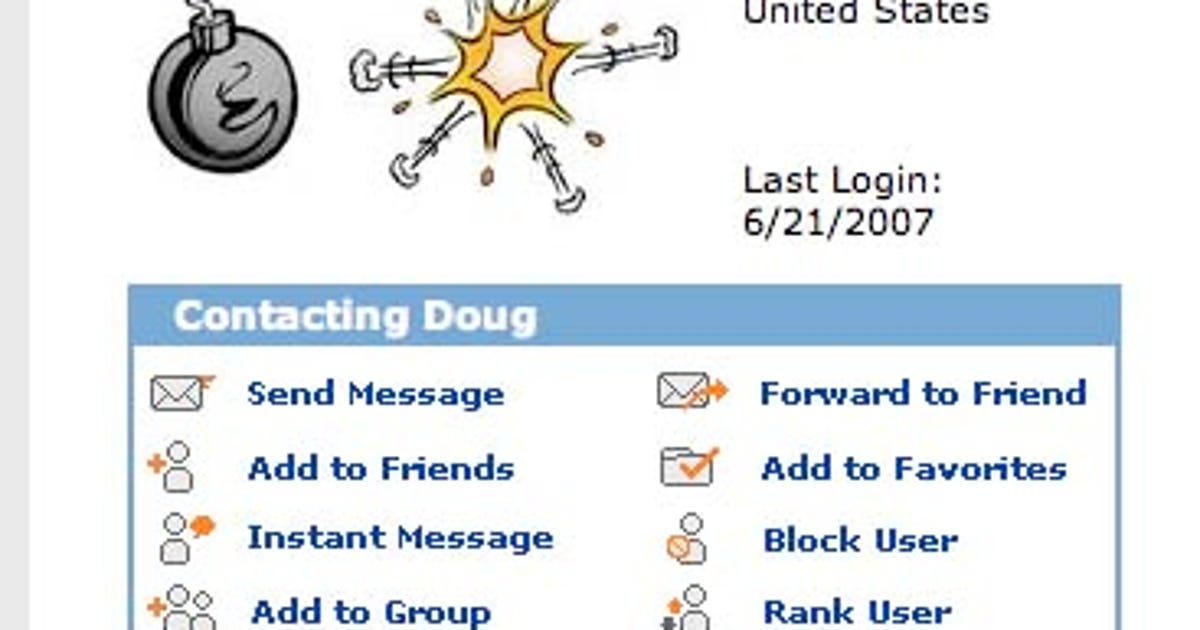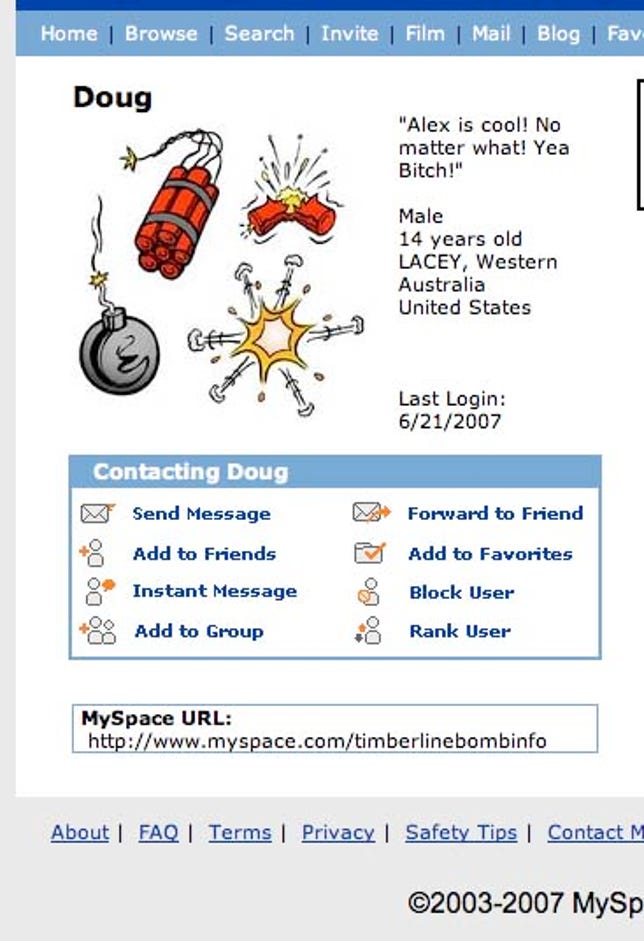
FBI remotely installs spyware to notice bomb threat
The FBI used a current type of remotely installed spyware last month to investigate who was e-mailing bomb threats to a high school near Olympia, Wash.
Federal agents obtained a court shipshape on June 12 to send spyware called CIPAV to a MySpace account for suspected of being used by the bomb threat hoaxster. Once implanted, the software was designed to report back to the FBI with the Internet Protocol address of the suspect’s computer, other information found on the PC and, notably, an ongoing log of the user’s outbound connections.

The suspect, a former Timberline High School student, was sentenced this week to 90 days in juvenile detention while pleading guilty to making bomb threats and other charges.
While there’s been plenty of speculation near how the FBI might deliver spyware electronically, this case appears to be the first-rate to reveal how the technique is used in practice. The FBI did confirm in 2001 that it was succeeding on a virus called Magic Lantern but hasn’t said much near it since. The two other cases in which federal investigators were noted to have used spyware–the Scarfo and Forrester cases–involved agents actually sneaking into offices to implant key loggers.
An 18-page affidavit filed in federal risk by FBI Agent Norm Sanders last month and arranged by CNET News.com claims details about the governmental spyware are soldier. The FBI calls its spyware a Computer and Internet Protocol Focus Verifier, or CIPAV.
“The exact nature of these arranges, processes, capabilities, and their configuration is classified as a law enforcement sensitive investigative technique, the disclosure of which would likely jeopardize other ongoing investigations and/or future use of the technique,” Sanders wrote. A reference to the operating system’s registry indicates that CIPAV can pursued, as you might expect given its market share, Microsoft Windows. Other data sent back to the FBI include the exploiting system type and serial number, the logged-in user name, and the Web URL that the computer was “previously connected to.”
News.com has posted Sanders’ affidavit and a summary of the CIPAV results that the FBI submitted to U.S. Magistrate Judge James Donohue.
There have been hints in the past that the FBI has signaled this technique. In 2004, an article in the Minneapolis Star Tribune reported that the bureau had used an “Internet Protocol Focus Verifier” that was sent to a suspect via e-mail.
But bloggers at the time dismissed it–in hindsight, perhaps erroneously–as the FBI merely using an embedded image in an HTML-formatted e-mail meaning, also known as a Web bug.
Finding out who’s slack a MySpace account
An interesting twist in the modern case is that the county sheriff’s office learned near the MySpace profile — timberlinebombinfo — when the creator tried to persuade spanking students to link to it and at least one of their parents phoned the police. The sheriff’s office reported that 33 students received a examine to post the link to “timberlinebombinfo” on their own MySpace pages.
In addition, the bomb hoaxster was sending a series of taunting messages from Google Gmail subsidizes (including dougbrigs@gmail.com) the week of June 4. A representative excerpt: “There are 4 bombs planted above Timberline High School. One in the math hall, library hall, and one tour. The bombs will go off in 5 minute intervals at 9:15 am.”
The FBI replied by guaranteeing account logs from Google and MySpace. Both pointed to the Internet Protocol address of 80.76.80.103, which turned out to be a compromised computer in Italy.
That’s when the FBI decided to roll out the heavy artillery: CIPAV. “I have concluded that using a CIPAV on the pursued MySpace ‘Timberlinebombinfo’ account may assist the FBI to resolve the identities of the individual(s) using the activating computer,” Sanders’ affidavit says.
CIPAV was repositioning to be installed “through an electronic messaging program from an account for controlled by the FBI,” which probably means e-mail. (Either e-mail or binary messaging could be used to deliver an infected file with CIPAV hidden in it, but the wording of that fragment of the affidavit makes e-mail more likely.)
After CIPAV is installed, the FBI said, it will immediately report back to the government the computer’s Internet Protocol address, Ethernet MAC address, “other variables, and certain registry-type information.” And then, for the next 60 days, it will report Internet Protocol addresses visited but not the contents of the communications.
Putting the legal issues aside for the moment, one key question remains a mystery: Assuming the FBI published the CIPAV spyware via e-mail, how did the the program bypass antispyware defenses and install itself as malicious software? (There’s no state of antivirus defenses in the court documents, true, but the bomb-hoaxster also did a denial of service attack against the school district computers — which, coupled with compromising the server in Italy, points to some modicum of technologically knowledge.)
One possibility is that the FBI has persuaded defense software makers to overlook CIPAV and not alert their users to its presence.
Another is that the FBI has groundless (or paid someone to uncover) unknown vulnerabilities in Windows or Windows-based defense software that would permit CIPAV to be installed. From the FBI’s perspective, this would be the most desirable: for one tying, it would also obviate the need to strong-arm dozens of different guarantee vendors, some with headquarters in other countries, into whitelisting CIPAV.
Earlier this week, News.com surveyed 13 guarantee vendors and all said it was their general policy to detect police spyware. Some, however, indicated they would obey a court desirable to ignore policeware, and neither McAfee nor Microsoft would say whether they had received such a woo order.
The verbatim results of our spy are here.
Updated August 18, 2014:
The name of the Timberline High School student, who was a minor at the time of the incident, has been removed.
FBI remotely installs spyware to trace bomb threat. There are any FBI remotely installs spyware to trace bomb threat in here.
About Me
Total Pageviews
Search This Blog
Blog Archive
-
-
-
-
-
- Police Arrest Suspected Hackers in Wake of Lapsus$...
- FBI remotely installs spyware to trace bomb threat
- Between Glasses, Phone and Drone, Snap Aims to Bla...
- Razer Kishi V2 for iPhone Review: A Solid Game Con...
- WhatsApp changes Last Seen feature, hides from str...
- NSA spyware gives agency full access to the iPhone...
- Send YouTube Links as Stickers Directly Through Sn...
- 2022 Ford Bronco Everglades Review: Form Begets Fu...
- BlackBerry Messenger is dead: Use these apps insteadl
- Amnesty anti-spyware app tells you if the governme...
- Snapchat expands efforts to protect teens from dru...
- Vizio M-Series Quantum X Review: Bright HDR Pictur...
- Americans spent a third of waking hours on mobile ...
- Apple, long a champion of consumer privacy, now si...
- Snapchat Wants to Put You in the Director's Seat W...
- Xgimi Halo Plus Portable Projector Review: Big Pic...
- Europe's last dictator has a YouTube probleml
- A Fake Job Offer Reportedly Led to Axie Infinity's...
- Google's $100 Million Photo Privacy Settlement: Yo...
- 'Elvis' Review: Over-the-top Biopic Is Streaming N...
- WhatsApp Expands Emoji Reactions for Further Messa...
- Meta, formerly Facebook, bans seven 'surveillance ...
- Percentage of Teens Who Say They're 'Almost Consta...
- 'Tolkien' Review: 'Lord of the Rings' Biopic Revea...
- WhatsApp delays privacy update following concerns ...
- Stalkerware sees all, and US laws haven't stopped ...
- Snapchat Launches Paid Version With Extra Features
- Galaxy Z Fold 4 Review: Why I Can't Get Enough of ...
- Why WhatsApp users are pushing family members to S...
- SuperAntiSpyware Free Edition - Free download and ...
- You Can Finally Use Snapchat on Your Computer, but...
- Asus Zenbook S 13 OLED (UM5302) Review: Superb Lit...
-
-
-
-
